#Twentieth Century (1934)
Text
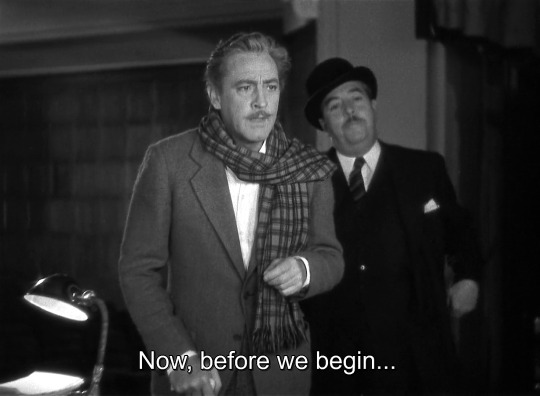

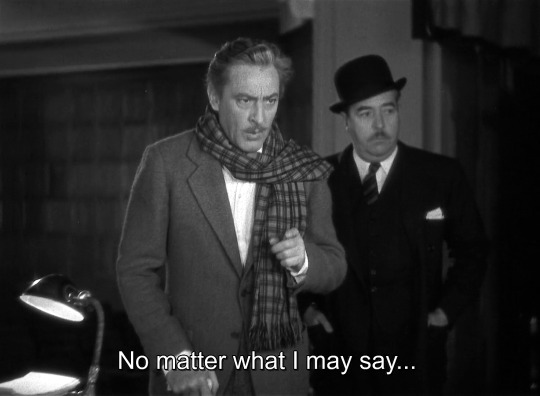
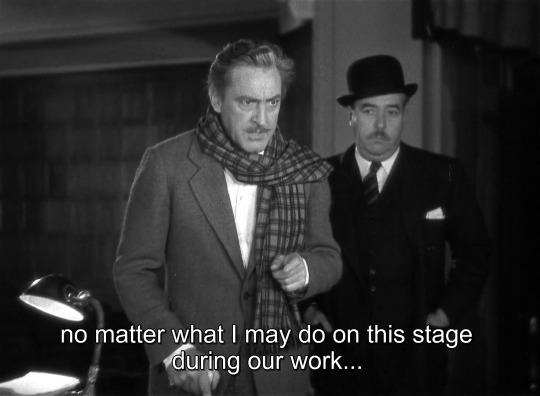
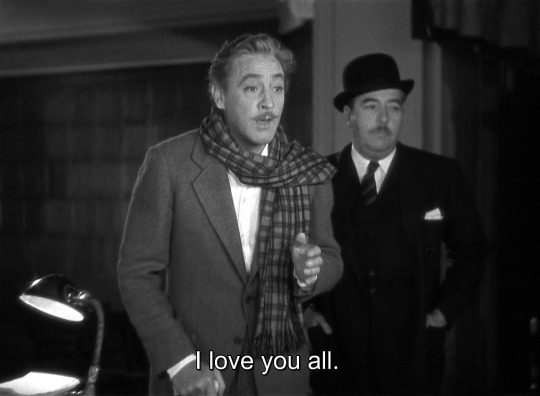
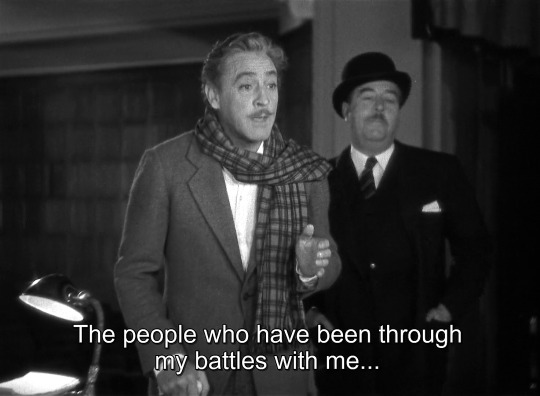

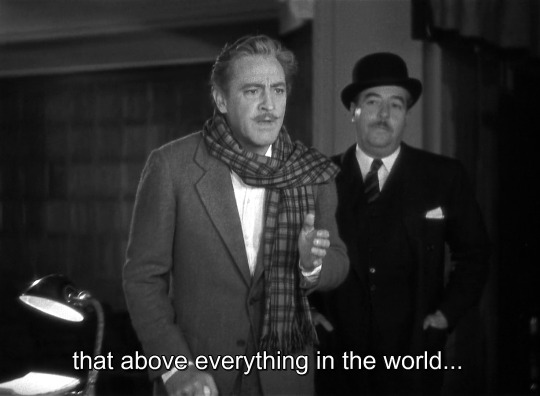


Twentieth Century (Howard Hawks, 1934).
#twentieth century#Twentieth Century (1934)#howard hawks#john barrymore#ben hecht#charles macarthur#joseph h. august#gene havlick#robert kalloch#preston sturges
35 notes
·
View notes
Text
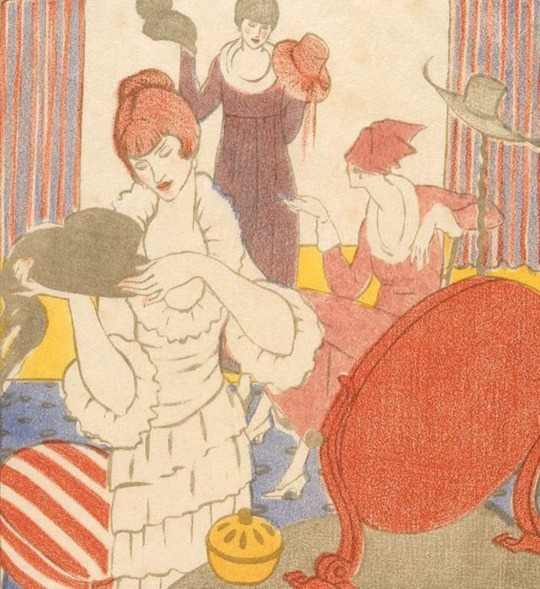

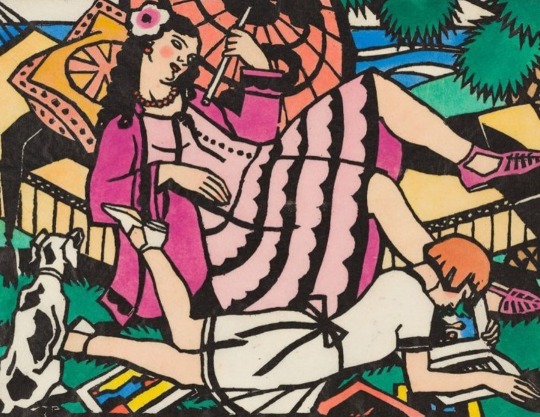
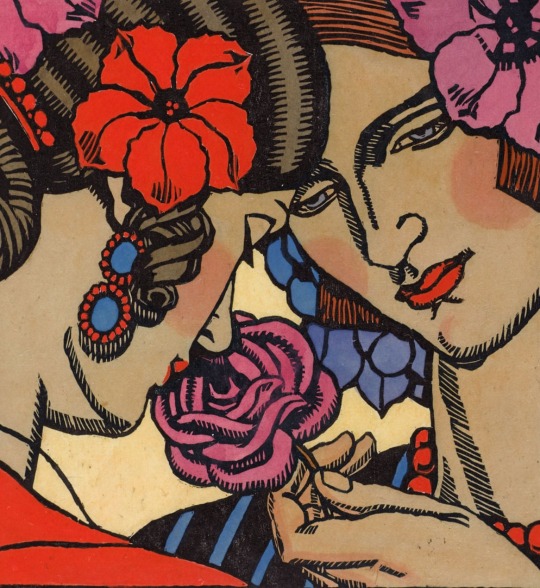

Thea Proctor (Australian, 1879-1966)
Alethea Mary Proctor's life as an artist encompassed more than half of the twentieth century. Born in Armidale in 1879 to parents who were soon to divorce, she weathered a disrupted childhood and a choppy education before beginning art study under Julian Ashton in Sydney when she was sixteen. At the Ashton school her fellow students included George Lambert, with whom she was to be closely associated in public and private over the next thirty years.
In 1903, burning with a need to learn to draw, she travelled to London, where Lambert and his family were established. She became one of his favourite models, a regular in his household, and his pupil. Although she was desperately poor, her beauty and livery nature allowed her to meet many of the leading figures of the fin de siecle art world, and all her life she was to carry with her the modernist precepts and influences she absorbed from figures such as Clive Bell, spectacles such as the Ballets Russes and exhibitions such as the post-Impressionist show at the Grafton Galleries in 1910-11. Aside from a return to Australia in 1913-14, she was to remain in England throughout her twenties and thirties.
Upon her return to Australia in 1921, which coincided with Lambert's, she immediately came to occupy a significant role in Sydney's volatile art world, and to disseminate her very strong ideas on modern art, interior decorating, fashion, costume, ballet and matters of taste in articles, lectures, formal classes, sketch clubs and at all conceivable social and artistic events. Strikingly beautiful, she never married, but supported herself into her eighties through art alone. She lived in a tiny rented flat in Double Bay, but until the early 1960s she was also able to maintain a studio in George Street, where she had lived before World War 2. In the inner city and the Eastern suburbs she became a familiar figure as immaculately dressed in brilliant purples, fuchsia and petunia shades she made her stately progress, parasol in gloved hand, seeking out the beautiful. (source)
The scenes of female intimacy in many of Proctor’s works have always been open to lesbian and queer readings. Women gaze intently at each other holding unfurled fans or proffering roses, symbols associated with female sexuality. Proctor moved in queer circles in Sydney in the 1920s and 1930s and was a valuable ally. JS MacDonald, the Art Gallery’s extremely conservative director from 1928 to 1936, wrote in 1934 of ‘the emergence of numbers of what the Americans call “pansies” … They rule the art world today, and, unless real painters speak up for themselves and right art, the women and their near-men abettors will ruin both.’ (source)
70 notes
·
View notes
Text
THIS DAY IN GAY HISTORY
based on: The White Crane Institute's 'Gay Wisdom', Gay Birthdays, Gay For Today, Famous GLBT, glbt-Gay Encylopedia, Today in Gay History, Wikipedia, and more … March 27



1878 – Henry Davis Sleeper (d.1934) was an American antiquarian, collector, and interior decorator best known for Beauport, his Gloucester, Massachusetts, country home that is "one of the most widely published houses of the twentieth century."
Henry Davis Sleeper was born in Boston. He was grandson of Jacob Sleeper, one of the founders of Boston University as well as a clothier and manager of a real estate trust.
Henry's education appears to have been by private tutors due to ill health as a child, and it is unclear as to whether he was ever formally educated.
Sleeper was introduced to the Eastern Point in Gloucester, Massachusetts, in the spring of 1906 by the Harvard economist A. Piatt Andrew, who later served in the U.S. House of Representatives, who had built a handsome summer mansion, Red Roof, on a rock ledge above the harbor.
Sleeper was much taken by the location and immediately decided to build a little further along the ledge from Red Roof. He purchased the land on Eastern Point in Gloucester on August 13, 1907.In the fall of 1907, construction of Beauport, Sleeper's relatively modestly scaled Arts and Crafts-style house, began and was sufficiently finished to receive A. Piatt Andrew as a house guest in May 1908. As property flanking Sleeper's became available, Beauport was expanded several times until 1925, often in response to events or important experiences in his life.
In 1918, Sleeper became the U.S. Representative of, and a major fundraiser for, the American Field Service, an ambulance corps founded by A. Piatt Andrew early in World War I. While Andrew served in the battle zones, Sleeper crisscrossed the Atlantic with supplies and funds, and worked closely with the French military. France awarded him the Croix de Guerre and the Legion of Honor.
Sleeper had never married and left no direct descendants. His relationship with Andrew, also a lifelong bachelor, was intense, and may have been a sexual one as well.
Sleeper died in Massachusetts General Hospital of leukemia on September 22, 1934, and is buried in his family's plot in Mount Auburn Cemetery in Watertown and Cambridge, Massachusetts. Andrew wrote the memorial tribute published in the Gloucester Daily Times.
Beauport House was declared a National Historic Landmark in 2003. In 2008, due to new information on Sleeper's life emerging, the decision was made to acknowledge his homosexuality in tour guides of Beauport, "not to define Sleeper but to contextualize him."


Portrait of de Maistre by Jean Shepeard
1894 – Roy de Maistre CBE (d.1968) was an Australian artist of international fame. He is famous in Australian art for his early experimentation in "colour-music", and is recognized as the first Australian artist to use pure abstractionism. His later works were painted in a figurative style generally influenced by Cubism. His 'Stations of the Cross' series hangs in Westminster Cathedral and works of his are hung in the Tate Gallery, London and in the Art Gallery of New South Wales. He was very close friends with the Australian writer Patrick White.
From his family's very prominent position in Australian society, he helped to make modern art fashionable in Sydney in the late 1920s, or at least as fashionable as it could be., but the anti-modernist criticism he received following his first one-man exhibition in Sydney convinced him that his art could not flourish in Australia.
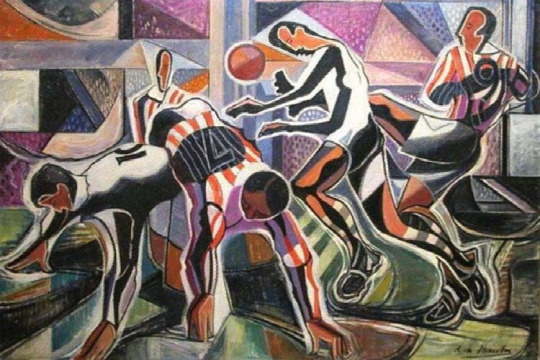
The Footballers
In March 1930 he left Australia to live permanently in London. He held one-man shows at the Beaux-Arts Gallery, London (1930); in the studio of his colleague Francis Bacon (1930); at Bernheim Jeune, Paris (1932); Mayor Gallery, London (1934); and at Calmann Gallery, London (1938).
In 1936 de Maistre met the 18 years younger novelist Patrick White. The two men never became lovers, but firm friends. In Patrick White's own words "He became what I most needed, an intellectual and aesthetic mentor". They had many similarities. They were both homosexual; they both felt like outsiders in their own families (for example de Maistre's family disapproved of his painting and described it as 'horrible'); as a result they both had ambivalent feelings about their families and backgrounds, yet both maintained close and life-long links with their families, particularly their mothers. They also both appreciated the benefits of social standing and connections; and Christian symbolism and biblical themes are common in both artists' work.

de Maistre's portrait of Patrick White
Patrick White dedicated his first novel Happy Valley (1939) to de Maistre, and acknowledged de Maistre's influence on his writing. He even went to St Jean de Luz during the writing of the novel under encouragement from de Maistre. In 1947 de Maistre's painting Figure in a Garden (The Aunt) was used as the cover for the first edition of Patrick White's The Aunt's Story. Patrick White also bought many of de Maistre's paintings for himself. In 1974 Patrick White gave all his paintings by de Maistre to the Art Gallery of New South Wales.
In 1940 de Maistre started work for the French Section, Joint War Organization of the British Red Cross Society and the Order of St John, London. In 1942 he was posted to Foreign Relations Department, British Red Cross Society. During this time de Maistre scarcely painted. After World War II, however, he had become an artist of the establishment. He had no trouble selling his paintings, and continuing to accept private commissions for society portraits. He died in 1968 in London.


Denton Welch: Self-portrait
1915 – Maurice Denton Welch was an English writer and painter, admired for his vivid prose and precise descriptions.(d.1948)
Welch was born in Shanghai and spent his childhood in China — he recorded this in his fictionalised autobiography of his early years, Maiden Voyage (1935). With the help and patronage of Edith Sitwell and John Lehmann this became a small but lasting success and made his reputation. It was followed by the novel In Youth is Pleasure (1943), a study of adolescence, and by Brave and Cruel (1949). An unfinished autobiographical novel A Voice through a Cloud was published posthumously in 1950.
Welch did not set out to be a writer. He originally studied art in London with the intention of becoming a painter. At the age of 20, he was hit by a car while cycling in Surrey and suffered a fractured spine. Although he was not paralysed, he suffered severe pain and complications, including spinal tuberculosis that ultimately led to his early death.
He met his companion, Eric Oliver, in November 1943 while he was convalescing. Oliver was a farm-worker living in Maidstone, and was a regular visitor. He acted as nurse for Welch, then his secretary, and finally as his literary executor when Welch died at the age of 33.
His literary work, intense and introverted, includes insightful portraits of his friends. He continued occasionally to paint; there is a fine self-portrait (in the National Portrait Gallery), and some line illustrations in the first editions of his books.
What is clear from Welch's writing is that his chief limitation is also his chief virtue: his focus on himself. For his time and place, Welch's novels are surprisingly suffused with homosexuality. His examination of the people around him, very thinly disguised in the novels, and his exploration of his own homosexual feelings and responses to the world show Welch to be a writer of consequence, if an over-looked one.
William S Burroughs cited Denton Welch as the writer who most influenced his own work, and dedicated his novel The Place of Dead Roads to Welch.
It may be that his most lasting work will be his posthumously published Journals, in which he is frank about his homosexuality.

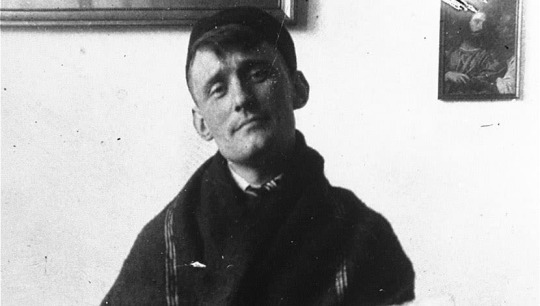
1943 – The Netherlands: A group of resistance activists led by Willem Arondeus, a gay man, dress as German soldiers, infiltrate the citizen registration building, and destroy it, hindering the Nazi German effort to identify Dutch Jews. The attack inspires similar ones throughout The Netherlands. Arondeus was a Dutch artist and author who joined the Dutch anti-Nazi resistance movement during World War II. Arondeus was caught and executed soon after his arrest. He was openly gay before the war and defiantly asserted his sexuality before his execution. His final words were "Let it be known that homosexuals are not cowards".


1963 – Dave Koz is an American smooth jazz saxophonist.
Dave Koz was born in Encino, California to Jewish parents. Although he is Jewish, Koz plays both Christmas and occasional Hanukkah songs at his concerts. He attended William Howard Taft High School in Woodland Hills, Los Angeles, California performing on saxophone as a member of the school jazz band. He later graduated from UCLA with a degree in mass communications in 1986, and only weeks after his graduation, decided to make a go of becoming a professional musician.
Within weeks of that decision, he was recruited as a member of Bobby Caldwell's tour. For the rest of the 1980s, Koz served as a session musician in several bands, and toured with Jeff Lorber. Koz was a member of Richard Marx's band and toured with Marx throughout the late 1980s and early 1990s. He also played in the house band of CBS' short-lived The Pat Sajak Show, with Tom Scott as bandleader.In 1990, Koz decided to pursue a solo career, and began recording for Capitol Records. His albums there include Lucky Man, The Dance, and Saxophonic. Saxophonic was nominated for both a Grammy Award and an NAACP Image Award. In 1994, Koz began hosting a syndicated radio program, The Dave Koz Radio Show (formerly Personal Notes), featuring the latest music and interviews with who's who in the genre. Dave co-hosted The Dave Koz Morning Show on 94.7 The Wave, a smooth jazz station in Los Angeles for six years. He decided to leave the show in January 2007 and was replaced by Brian McKnight. In 2002, Koz started a record label, Rendezvous Entertainment, with Frank Cody and Hyman Katz.
In an April 2004 interview with The Advocate, Koz came out publicly as gay.


Blake McIver Ewing - Then and Now
1985 – Blake McIver Ewing also known as Blake McIver and Blake Ewing, is an American singer-songwriter, actor, model and pianist. He was known for playing Michelle's friend, Derek, on the sitcom Full House. Ewing also portrayed the role of Waldo in the 1994 feature film version of The Little Rascals, and voiced Eugene on Hey Arnold! during its 5th season. He is currently one of the hosts of the Bravo series The People's Couch.Ewing co-wrote and performed the song "Along the River", the end credit song for the film End of the Spear. He has contributed his work to the It Gets Better Project, citing his own experiences as a gay teenager as his motivation. His debut album, The Time Manipulator, was released in May 2014. Throughout 2013 Ewing worked as a go-go dancer in Los Angeles. "The tips were good. In fact, I raised so much money, I was able to finish my record — mission accomplished."
Ewing was nominated for an Ovation Award for his role as "The Little Boy" in the Los Angeles production of Ragtime. He is a graduate of UCLA.
Blake released his equality anthem "This Is Who We Are" on July 14, 2015 and works as a host for AfterBuzz TV.

Blake Mciver Ewing has apparently done a lot of growing up over the years and is now a living his life as a proud gay man. He is also a regular fixture on "The People's Couch," providing witty commentary about television shows and viral clips alongside openly gay entertainer Scott Nevins.
"When I was 14 I came very close to becoming a gay teen suicide 'statistic' but I then turned to music, my piano, my loved ones, and discovered that it does in fact get better," the actor noted in a YouTube description of him performing a poignant anti-bullying song. "But that being said, I believe we must raise awareness to protect the LGBT teens who are still being physically and verbally assaulted and fear for their lives every day. We also have a responsibility to end this suicide epidemic."


2009 – Japan acknowledges its nationals same-sex marriages to foreigners from countries or states where same-sex marriages are legal.


25 notes
·
View notes
Text
hiiiii everyone im going to make you look at art <3 okay <3


first up we got two photos from august sander's people of the twentieth century, a decades long project he never finished aimed at identifying and organizing the "types" of people in early twentieth century germany. in photos for this project he usually identified people along socio-economic and geographic lines. on the left we have officer, world war i, cologne (1914) and on the right we have boxers, cologne (1928). museum had a bunch of sander on display and they paired it with the shortcut to the systematic life: superficial life (2002) by tsui kuang-yu, which is outside the scope of this post but super interesting so i encourage everyone to look it up lol

up next: the junkers officer (1934) by george grosz, another artist associated with neue sachlichkeit/new objectivity. im not well versed in german art but recently i have been so intrigued by leftist art of the weimar republic and it felt simply serendipitous. unfortunately by the time i saw this the museum was closing in 15 minutes so i had to rush out </3 SAD
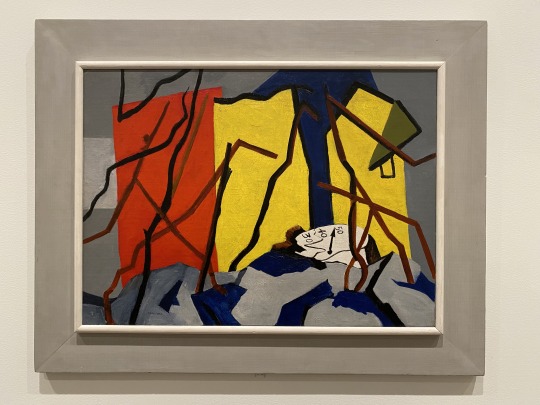
this is air war (1944) by ralston crawford. first time i heard of this artist! during wwii he served as chief of the visual presentation unit of the weather division of the army air corps in washington dc and southeast asia.
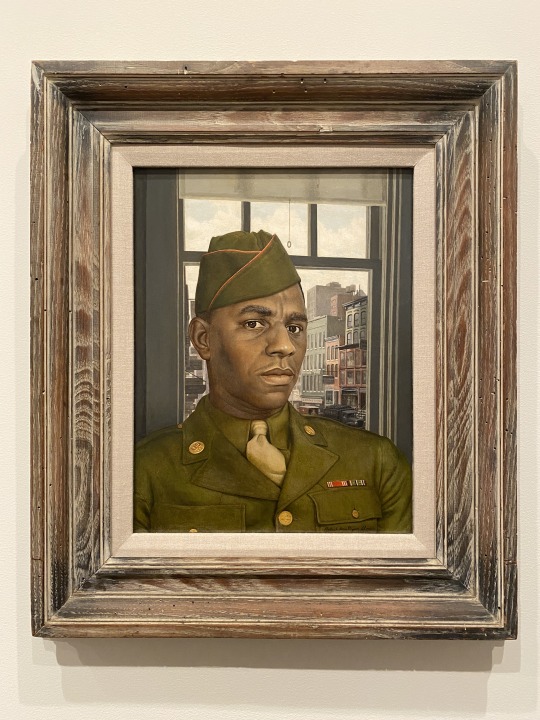
negro soldier (1945) by robert smullyan sloan. sloan was drafted in 43 and illustrated army educational materials and posters for war bonds. the wall label says the title was given by the artist, which makes me think sloan didn't personally know this guy, which makes me very curious about the circumstances of its production. no name is given to the sitter, but he served in the european-african-middle eastern campaign in the army and was awarded a good conduct medal. sloan has a drawing at the met (station hospital [1943-44] ), but unfortunately i can't find much else about him online that might help contextualize this painting.
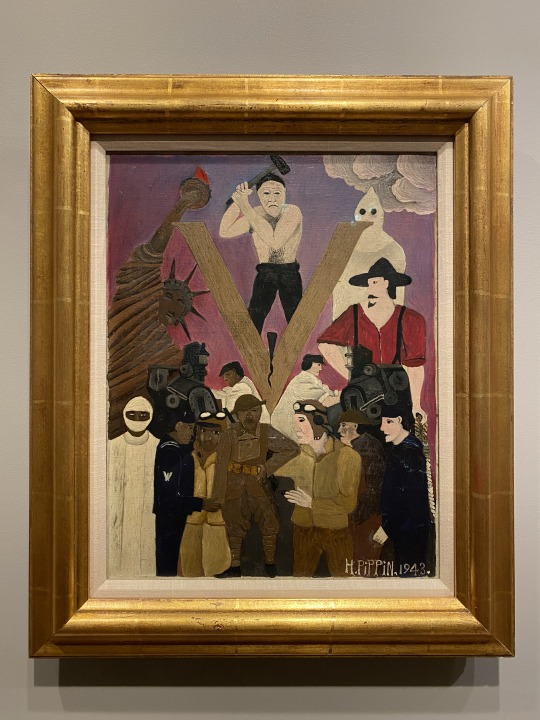
i think it pairs really well with this horace pippin from 1943 called mr. prejudice. pippin served in wwi with the harlem hellfighters, and the soldier at center might be a self portrait. he has a pretty good amount of paintings about the war actually -- i normally associate him with landscapes for some reason, though i think thats just because the pippin at my local art museum is a landscape lmao. his illustrated war journals are digitized at the archives of american art if you want to check it out!
up next are some pieces of interest that i want to share but about which i otherwise have little to say
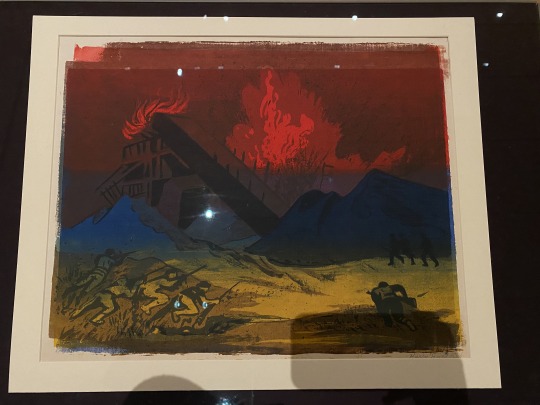

L: untitled (military maneuvers at an abandoned mine) (1940-42) by harry gottlieb
R: italy goes to war (1941) by arthur dove
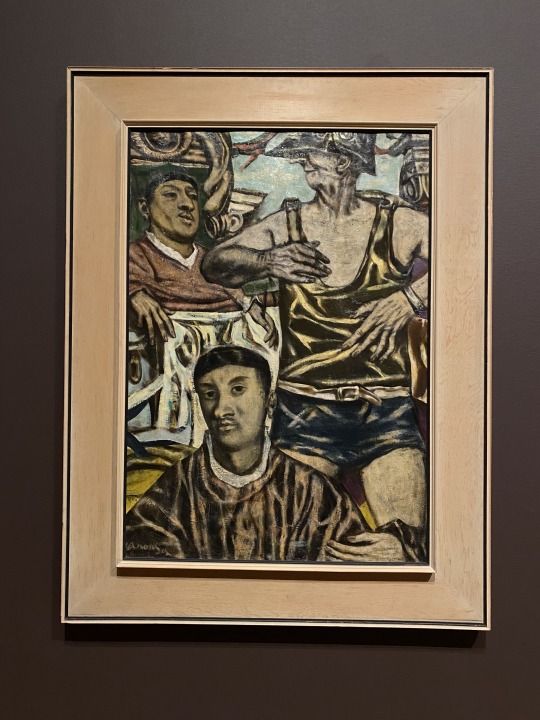
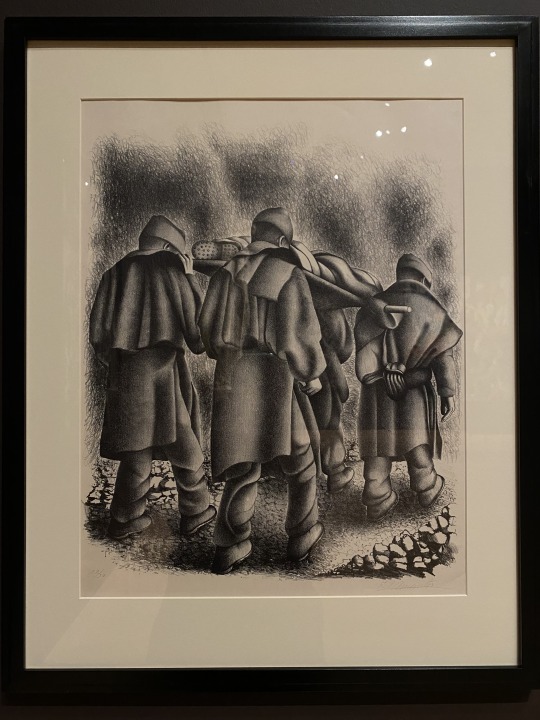
L: christ before pilate (1949) by david aronson. wall text wants us to note the soldier's helmet is german
R: the funeral (1949) by francisco dosamantes
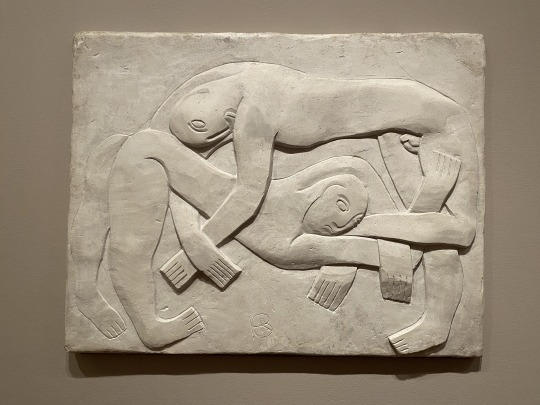
ending with this delightful 1914 the wrestlers by henri gaudier-brzeska, whom the label quotes as saying, "i went to see the wrestlers -- God! i have seldom seen anything so lovely... they fought with amazing vivacity and spirit, turning in the air, falling back on their heads, and in a flash were up again on the other side, utterly incomprehensible." something about wrestling/boxing that make men gay as fuck. beautiful
15 notes
·
View notes
Text
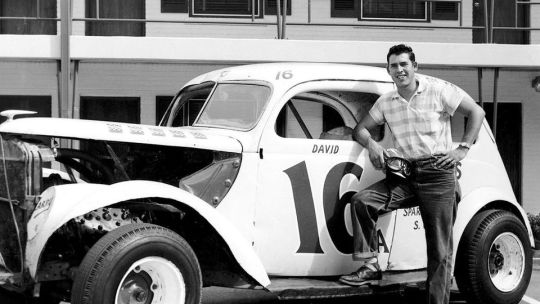
David Pearson
David Pearson (1934 – 2018) was one of NASCAR’s first superstars. He was nicknamed “the Fox,” and later “the Silver Fox,” for his cunning and calculated driving. Over the course of his 27-year NASCAR career he accumulated 105 victories and a mountain of accolades. He was Rookie of the Year in 1960, three-time Series Champion (1966, 1968, 1969), and inducted into several motorsport halls of fame. In 1999 40 NASCAR insiders selected him as Sports Illustrated’s Top Stock Car Driver of the Twentieth Century.
#David Pearson#car#cars#nascar#nascar cup#nascar cup series#cup series#stock car racing#motor racing#the Silver Fox
18 notes
·
View notes
Text
Alfred Rosemberg

This is Alfred Rosemberg, the ideologue of the Nazi Party, timeline:
1893: He was born in Reval.
1911: He graduated from the Petri-Realschule in Reval and enrolled at the Riga Polytechnic.
1914: The First World War began.
1914: The headquarters of the Polytechnic University was temporarily moved to Moscow.
1915: He married his first wife, Hilda Leesmann.
1917: He participated in the Russian revolution on the side of the counter-revolutionaries.
1918: The first world war ended.
1918: He immigrated to Germany.
1918: He contributed to Dietrich Eckart's publication, the Völkischer Beobachter.
1919: He published his two anti-Semitic treatises, The Journey of the Jews Through the Centuries and Immorality in the Talmud.
1919: He conceived a theory about a global Judeo-Bolshevik-Masonic conspiracy.
1919: He joined the Nazi Party
1923: He became the editor of the Völkischer Beobachter
1923: After the failed Beer Hall Putsch, Hitler appointed Rosenberg as a leader of the National Socialist movement, a position he held until Hitler's release. Hitler remarked privately in later years that his choice of Rosenberg, whom he regarded as weak and lazy, was strategic.
1923: He divorced his first wife.
1924: Hitler was released.
1925: He married his second wife, Hedwig Kramer.
1929: He founded the Militant League for German Culture.
1930: His only daughter, Irene Rosemberg, was born.
1930: He became a Reichstag Deputy
1930: He published his book on racial theory The Myth of the Twentieth Century.
1932: He participated in the Volta Conference.
1933: Adolf Hitler was appointed Chancellor of Germany.
1933: He was assigned the role of "Delegate of the Führer for the education and intellectual and philosophical formation of the National Socialist party".
1933: He visited Britain, intending to give the impression that the Nazis would not be a threat.
1933: He was appointed "Responsible for Foreign Affairs for the Party".
1934: Hitler granted Rosenberg responsibility for the spiritual and philosophical education of the Party and all related organizations.
1939: Again due to his strong knowledge of the Jewish question, he founded the "Institute for studies on the Jewish question" on Hitler's orders.
1939: The Second World War began.
1940: He founded his own operational staff, called Einsatzstab Reichsleiter Rosenberg (or Commando Rosenberg), which was mainly (if not exclusively) responsible for stealing works of art from all the occupied territories of Europe but particularly from France.
1940: He was made head of the Hohe Schule (literally "high school", but the German phrase refers to a college), the Centre of National Socialist Ideological and Educational Research.
1941: He was appointed minister of the occupied territories.
1942: He issued an Agrarian Law annulling all Soviet legislation on farming, restoring family farms for those willing to collaborate with the occupiers
1945: The Second World War ended.
1945: He was captured by the Allies.
1945: He was tried at the Nuremberg trials.
1946: He was found guilty and sentenced to death.
1946: He died.
Sources:
Wikipedia: Alfred Rosemberg
MIlitary Wiki: Alfred Rosemberg
❗❗I DON'T SUPPORT NAZISM,FASCISM OR ZIONISM IN ANY WAY, THIS IS JUST AN EDUCATIONAL POST❗❗
16 notes
·
View notes
Text
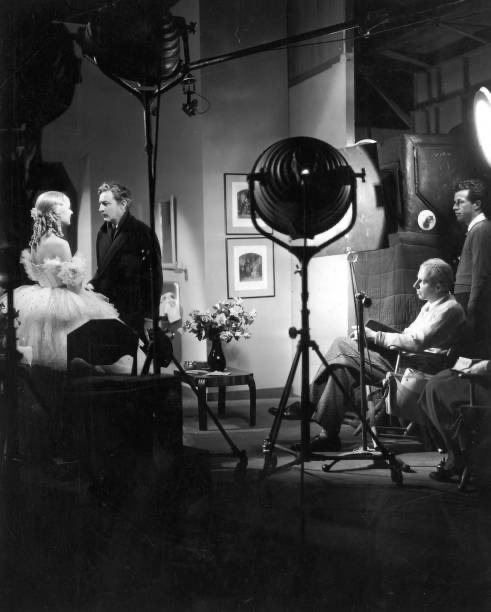
Director Howard Hawks watching Carole Lombard and John Barrymore perform a scene on set of TWENTIETH CENTURY (1934)
29 notes
·
View notes
Note
Old movies for bookish, nerdy girls that already need a break from studying? 😓
here are a bunch of movies i like that give me bookish, rainy, cozy, watch at midnight vibes~
♡ the big sleep (1946)
♡ the maltese falcon (1941)
♡ laura (1944)
♡ mildred pierce (1945)
♡ notorious (1946)
♡ out of the past (1947)
♡ it's love i'm after (1937)
♡ old acquaintance (1943)
♡ the ex-mrs. bradford (1936)
♡ star of midnight (1935)
♡ ball of fire (1941)
♡ funny face (1957)
♡ twentieth century (1934)
♡ camille (1936)
♡ rebecca (1940)
♡ all about eve (1950)
♡ a letter to three wives (1949)
♡ the last time i saw paris (1954)
♡ leave her to heaven (1945)
♡ grand hotel (1932)
♡ the bad and the beautiful (1952)
♡ peyton place (1957)
♡ who's afraid of virginia woolf? (1966)
♡ dead poets society (1989)
enjoy your break!!!
25 notes
·
View notes
Text

Hello everyone! A new month is coming, which means we're going to start a new book. This time, I've collected a list of books that are all about nature. As always, please remember to vote for your favourite using the link at the end of the post. And now onto the books!
The Overstory, by Richard Powers
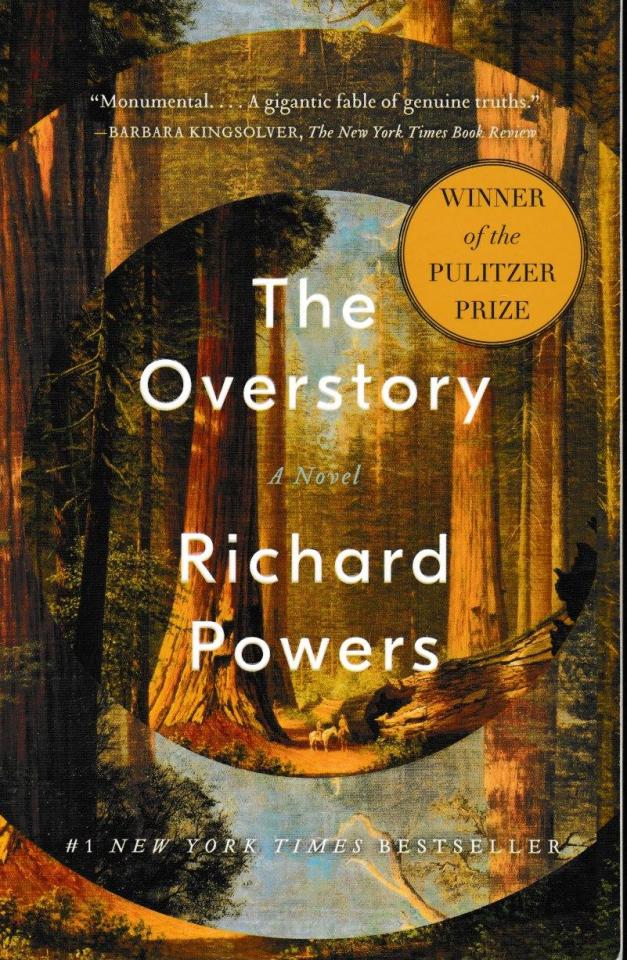
The Overstory is a sweeping, impassioned work of activism and resistance that is also a stunning evocation of - and paean to - the natural world. From the roots to the crown and back to the seeds, Richard Powers’s twelfth novel unfolds in concentric rings of interlocking fables that range from antebellum New York to the late twentieth-century Timber Wars of the Pacific Northwest and beyond. There is a world alongside ours—vast, slow, interconnected, resourceful, magnificently inventive, and almost invisible to us. This is the story of a handful of people who learn how to see that world and who are drawn up into its unfolding catastrophe.
Greenwood, by Michael Christie

It's 2034 and Jake Greenwood is a storyteller and a liar, an overqualified tour guide babysitting ultra-rich vacationers in one of the world's last remaining forests.
It's 2008 and Liam Greenwood is a carpenter, fallen from a ladder and sprawled on his broken back, calling out from the concrete floor of an empty mansion.
It's 1974 and Willow Greenwood is out of jail, free after being locked up for one of her endless series of environmental protests: attempts at atonement for the sins of her father's once vast and violent timber empire.
It's 1934 and Everett Greenwood is alone, as usual, in his maple syrup camp squat when he hears the cries of an abandoned infant and gets tangled up in the web of a crime that will cling to his family for decades.
And throughout, there are trees: thrumming a steady, silent pulse beneath Christie's effortless sentences and working as a guiding metaphor for withering, weathering, and survival.
Beasts of Extraordinary Circumstance, by Ruth Emmie Lang

Orphaned, raised by wolves, and the proud owner of a horned pig named Merlin, Weylyn Grey knew he wasn’t like other people. But when he single-handedly stopped that tornado on a stormy Christmas day in Oklahoma, he realized just how different he actually was.
That tornado was the first of many strange events that seem to follow Weylyn from town to town, although he doesn’t like to take credit. As amazing as these powers may appear, they tend to manifest themselves at inopportune times and places. From freak storms to trees that appear to grow over night, Weylyn’s unique abilities are a curiosity at best and at worst, a danger to himself and the woman he loves. But Mary doesn’t care. Since Weylyn saved her from an angry wolf on her eleventh birthday, she’s known that a relationship with him isn’t without its risks, but as anyone who’s met Weylyn will tell you, once he wanders into your life, you’ll wish he’d never leave.
Beasts of Extraordinary Circumstance tells the story of Weylyn Grey’s life from the perspectives of the people who knew him, loved him, and even a few who thought he was just plain weird. Although he doesn’t stay in any of their lives for long, he leaves each of them with a story to tell. Stories about a boy who lives with wolves, great storms that evaporate into thin air, fireflies that make phosphorescent honey, and a house filled with spider webs and the strange man who inhabits it.
There is one story, however, that Weylyn wishes he could change: his own. But first he has to muster enough courage to knock on Mary’s front door.
The Lost City of Z, by David Grann
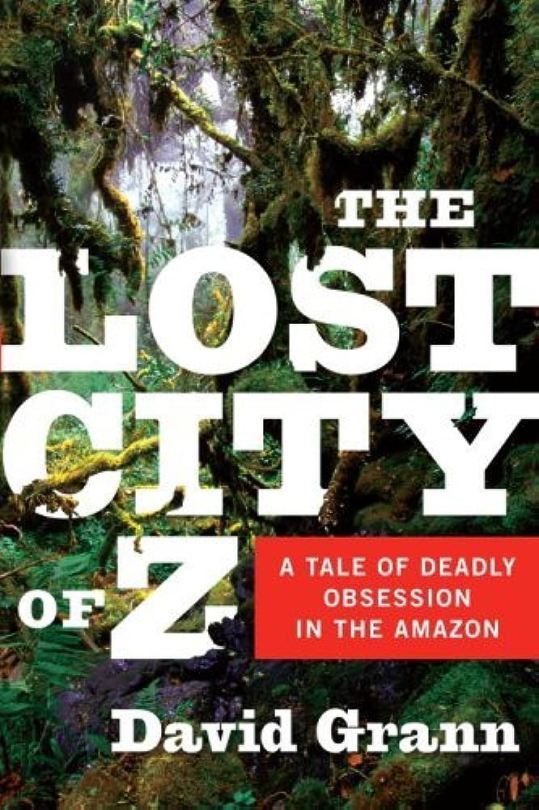
After stumbling upon a hidden trove of diaries, New Yorker writer David Grann set out to solve "the greatest exploration mystery of the 20th century": What happened to the British explorer Percy Fawcett & his quest for the Lost City of Z?
In 1925, Fawcett ventured into the Amazon to find an ancient civilization, hoping to make one of the most important discoveries in history. For centuries Europeans believed the world's largest jungle concealed the glittering kingdom of El Dorado. Thousands had died looking for it, leaving many scientists convinced that the Amazon was truly inimical to humans. But Fawcett, whose daring expeditions inspired Conan Doyle's The Lost World, had spent years building his scientific case. Captivating the imagination of millions round the globe, Fawcett embarked with his 21-year-old son, determined to prove that this ancient civilisation--which he dubbed Z--existed. Then his expedition vanished. Fawcett's fate, & the tantalizing clues he left behind about Z, became an obsession for hundreds who followed him into the uncharted wilderness.
For decades scientists & adventurers have searched for evidence of Fawcett's party & the lost City of Z. Countless have perished, been captured by tribes or gone mad. As Grann delved ever deeper into the mystery surrounding Fawcett's quest, & the greater mystery of what lies within the Amazon, he found himself, like the generations who preceded him, being irresistibly drawn into the jungle's green hell. His quest for the truth & discoveries about Fawcett's fate & Z form the heart of this complexly enthralling narrative.
Prodigal Summer, by Barbara Kingslover
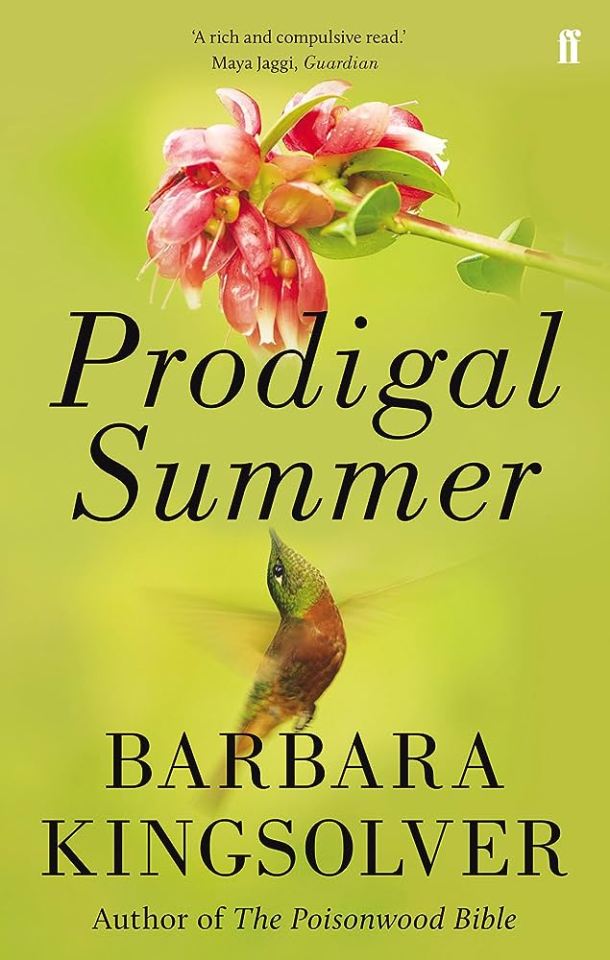
It is summer in the Appalachian mountains and love, desire and attraction are in the air. From her outpost in an isolated mountain cabin, Deanna Wolfe, a reclusive wildlife biologist, watches a den of coyotes. She is caught off guard by a young hunter who invades her most private spaces and interrupts her solitary life.
On a farm several miles down the mountain, Lusa Maluf Landowski, a bookish city girl turned farmer's wife, finds herself marooned in a strange place where she must declare or lose her attachment to the land that has become her own. And a few more miles down the road, a pair of elderly feuding neighbours tend their respective farms and wrangle about God, pesticides, and the possibilities of a future neither of them expected. Over the course of one humid summer, these characters find their connections of love to one another and to the surrounding nature with which they share a place.
Please vote for our next book here.
#books#booklr#book list#book club#nature#the overstory#greenwood#beasts of extraordinary circumstance#the lost city of z#prodigal summer
23 notes
·
View notes
Text

“Red Sun” (1934) by Fujimaki Yoshio (藤牧 義夫; 1911 - 1935), a Japanese woodblock artist active in the early twentieth century as a member of the sōsaku-hanga (創作版画, creative prints) art movement.
21 notes
·
View notes
Text
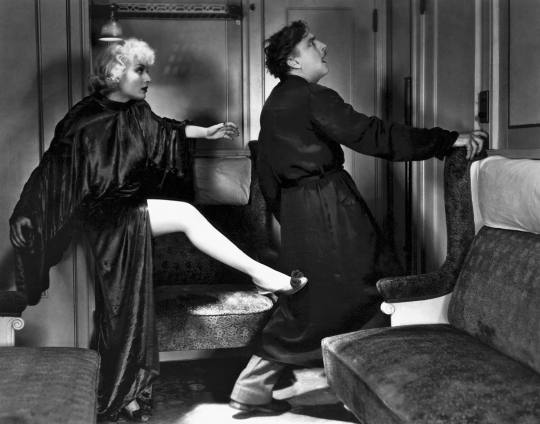
John Barrymore, February 15, 1882 – May 29, 1942.
With Carole Lombard in Howard Hawks’s Twentieth Century (1934).
39 notes
·
View notes
Text
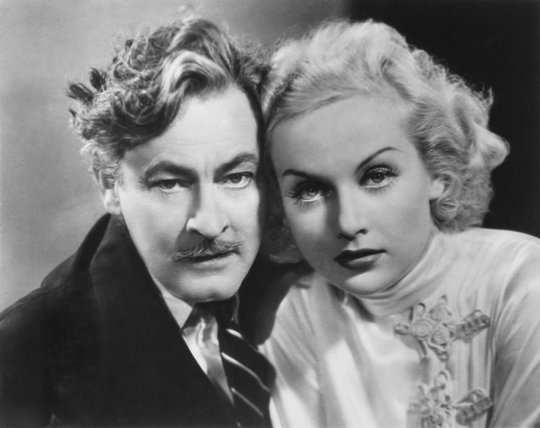
John Barrymore-Carole Lombard "La comedia de la vida" (Twentieth century) 1934, de Howard Hawks.
34 notes
·
View notes
Text
THIS DAY IN GAY HISTORY
based on: The White Crane Institute's 'Gay Wisdom', Gay Birthdays, Gay For Today, Famous GLBT, glbt-Gay Encylopedia, Today in Gay History, Wikipedia, and more … April 17


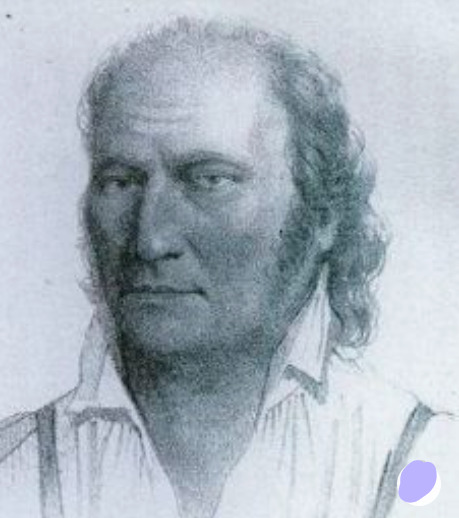
1725 – South Africa: Leendert Hasenbosch (c.1695–1725), a Dutch East India Company employee, is convicted of sodomy on a ship in Capetown. He’s left on Ascension Island as punishment and dies of thirst six months later. He kept a diary entitled Sodomy Punish’d which was published in 1726. In 2006 the full story was published by Alex Ritsema, with the support of Koolbergen’s family and publisher, in the book A Dutch Castaway on Ascension Island in 1725; a second, revised edition was printed in 2010.
1857 – Maine sets a one-year minimum for sodomy and eliminates the word "detestable" from the sodomy law.
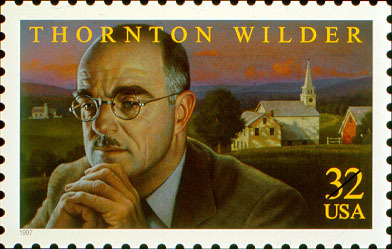
1897 – Born: Pulitzer Prize-winning American playwright and novelist Thornton Wilder (d.1975), a prolific writer prominent in twentieth-century literature. A discreet homosexual, his sexual proclivities were kept far out of the limelight. Wilder's mainstream literary works are landmarks of American literature, but they reveal scant traces of his homosexuality. He can be credited for acting as a behind-the-scenes ambassador for the Lost Generation, making their avant-garde themes accessible to a middle-brow American public.
Wilder was born in Wisconsin though he spent most of his boyhood in Berkeley, California. As an adolescent, Wilder isolated himself in academic projects. Wilder's entire family was one of achieving, industrious, self-reliant Congregationalists with a strong work ethic.His roving intellectual enthusiasms blossomed in his adolescence, especially his interest in theater. At fifteen the budding playwright was cast as Lady Bracknell in Oscar Wilde's The Importance of Being Earnest, but his strict father forbade this drag role. Later, Wilder delighted in playing central characters in his own plays, such as the Stage Manager in Our Town and Mr. Antrobus in The Skin of Our Teeth.
Wilder described himself as "The only writer of the Lost Generation who did not 'go' to Paris," a statement that was not literally true but which expresses his attachment to American life and values even as many of the writers of his generation yearned to escape what they saw as the stifling conformity of small-town life.
Wilder's warmest friendships included Gertrude Stein and Alice Toklas whom he met in Chicago in 1934. Through them he befriended many of the gay artists in their circle. For all the liberation of the Jazz Age and the period following, homosexuality was only discreetly discussed among writers of the Lost Generation.
Wilder seems to have been regarded even by his closest friends as a kind of Henry James figure, somewhat sheltered and cerebral, and frightened of sex. The relationship between Wilder and his one documented companion, Sam Steward, (aka Phil Andros) may have begun as a furtive sexual fling in Zurich in 1937. Steward, a writer, pornographer, tattoo artist, and one-time college professor, was, in pointed contrast to Wilder, open and adventurous. He wrote popular erotic gay works in the 1970s under the pseudonym Phil Andros. Wilder seems to have backed away from Steward after several awkward encounters. Intimate affection eventually became fond intellectual acquaintance.
Typical of some gay men of the era, Wilder preferred to play the role of the perennial Respectable Bachelor. Although he never publicly discussed his homosexuality, later in his life he is believed to have had discreet affairs with younger men. Despite his reticence concerning his sexuality, Wilder was a notably convivial man who enjoyed friendships with writers and actors and academics.
Wilder is the only writer to receive Pulitzer Prizes for both literature (The Bridge of San Luis Rey, 1927) and drama (Our Town, 1938; The Skin of Our Teeth, 1943).
During World War II, Wilder enlisted in the armed services, eventually becoming a Lieutenant Colonel in the Air Force. In the 1940s, Wilder also wrote the screenplay for Alfred Hitchcock's Shadow of a Doubt (1943).
After the war, he reworked an earlier play, The Merchant of Yonkers (1938), a comedy set in New York in the 1880s, that features the adventures of a neighborhood matchmaker, Dolly Levi, who eventually snares herself the perfect husband. It was not much of a success originally, but it became The Matchmaker (1955), a popular vehicle for Ruth Gordon, and it evolved into the even more popular Jerry Herman-Michael Stewart musical Hello, Dolly! (1964).
Thornton Wilder died on December 7, 1975. In Wilder's public and personal life, the "love that dared not speak its name" usually remained unspoken. One can only wonder whether he might have addressed more explicitly the question of homosexuality (and its repression) had he lived in a more tolerant time or place.

1919 – Chavela Vargas is a household name in Mexico but many North Americans aren’t privy to one of the most passionate performers of the last century. The queer masculine-presenting singer was prized for her tragic, tearful emoting — her songs appear in Pedro Almodovar films like Flower of My Secret.
A late bloomer, perhaps, but what a flower — Chavela Vargas did not release her first album until she was 42, didn't come out as a lesbian until she was 81, and didn't debut at Carnegie Hall until she was 83.
What was she doing all those years before recording Noche de Bohemia in 1961? Well, she dressed as a man, often in her signature red jorongo, smoked cigars, drank heavily, and packed a pistol, so obviously she was busy with more than singing rancheras in the streets. And maybe she had an affair with famed Mexican painter, Frida Kahlo (as Josephine Baker had).
Since that first record, she has released more than eighty albums. Her great fame of the 1960s and 70s subsided when she retired to battle her alcoholism. She returned to performing at 72 in 1991 in Mexico City. Since then her music has been widely used in films and she has appeared singing in several movies including Almodovar's Flower of My Secret, Julie Taymor's Frida, and Alejandro Innartu's Babel.
Buy her, beware: The first time you hear Chavela unleash her power midway through the quiet Paloma Negra you might drop whatever you're holding. She died in 2012 at 93.
youtube

Lindsay Anderson with Malcolm McDowell
1923 – Born: Film and stage director Lindsay Anderson (d.1994), a foundational figure in the "Free Cinema" movement of the 1950s, a group of British filmmakers who created low-scale realist works that focused on the ordinary or the socially marginalized, particularly the working class and the younger generation. A leader among such peers as Karel Reisz, Tony Richardson, Gavin Lambert, and John Schlesinger, Anderson was influential in shaping what now might well be considered the golden age of British cinema in the 1960s. Ironically, as a result of his independence and idealism, he directed relatively few major films, and both his professional and personal lives were affected by the repression and sublimation of his homosexuality.
Anderson was born in Bangalore, India, where his father was a captain in the British army. His family sent him to Cheltenham, an English private school, where he met his lifelong friend and colleague, Gavin Lambert, who like Anderson, was not only gay but would also enjoy a significant directorial career. Subsequently, Anderson attended Oxford University, where he specialized in Classics and later co-founded the film journal Sequence with Lambert. In his essays and reviews in Sequence and other journals, Anderson took aim against the conventions of contemporary British cinema, which tended to avoid controversy and favored the lives and loves of the upper middle class as its subject matter.
Anderson's first films were short semi-documentary studies, looking at the everyday activities of the lower classes. Yet while Anderson had paved the way for feature films about the lives of working-class individuals, such as those that Richardson, Reisz, and Schlesinger directed throughout the early 1960s, he left filmmaking in 1957, when he became a director at the Royal Court Theatre, London. In this capacity Anderson directed many major theatrical works, including the 1975 revival of Joe Orton's What the Butler Saw, the first unexpurgated performance of the play.
It was not until 1963, that he made his first feature film, This Sporting Life, which, in detailing the career of a young coal miner turned professional footballer, seemed to follow rather than lead then-current trends. As such, it was not a commercial success, yet it is significant inasmuch as its depiction of the frustration and the emotional and physical violence that characterize the lives of ostensibly heterosexual working-class men has an inescapable homoerotic undercurrent, as seen in the film's nude bathing scenes.
Many of these themes, although in a very different context, recur in Anderson's best known film, If... (1968). Set in a British private school--indeed, filmed at Cheltenham--the film explores the social fascism that is inculcated in such privileged institutions and ends with student rebels machine-gunning a school assembly. It is also noteworthy for its frank representation of homosexual relationships among the schoolboys.Although If... was well-received as a cinematic political statement in the zeitgeist of the late 1960s, Anderson's subsequent films, though often equally daring, fared less well. O Lucky Man! (1973), the second of a trilogy featuring the character Mick Travis, the protagonist of If... (played by Malcolm McDowell), is a rambling three-hour satire in the mode of Voltaire's Candide on the evils of military-industrial capitalism and scientific experimentation. Ambitious and idealistic, the film was nonetheless a commercial failure, and, as a result, Anderson had few offers or financial backers for subsequent film projects. The third film of the trilogy, the cult classic Britannia Hospital (1982), is a satire on the British national health service. During the 1970s and 1980s, Anderson continued to direct for the stage and directed a number of television plays.
On August 30, 1994, he died of a heart attack while in southern France. Despite Anderson's daring as a director, his recently published letters and Lambert's biography show a tormented man who struggled with his own sexuality. He tended to fall in love with his leading men, including Richard Harris, Albert Finney, and Malcolm McDowell, all of whom were heterosexual, married, and unattainable. His closest associates have speculated that his life was, for the most part, a celibate one. His films, in which homoerotic elements are often presented in a violent or disturbing manner, became the outlet for the desires he could not express in life.

1943 – Tommy Nutter (d.1992), was a British tailor, famous for reinventing the Savile Row suit in the 1960s.
Born in Barmouth, Nutter initially studied plumbing, and then architecture, but he abandoned both aged 19 to study tailoring at the Tailor and Cutter Academy.
In the early 1960s he joined traditional tailors Donaldson, Williamson & Ward. After seven years, in 1969, he joined up with Edward Sexton, to open Nutters of Savile Row at No 35a Savile Row. They were financially backed by Cilla Black and her husband Bobby Willis, Managing Director of the Beatles' Apple Corps Peter Brown, and lawyer James Vallance-White.
The business was an immediate success, as Nutter combined traditional tailoring skills with innovative design. He designed for the Hardy Amies range, and then for the man himself. His clients included his investors, plus Sir Roy Strong, Mick Jagger, Bianca Jagger and Elton John. Nutter himself was most proud of the fact that, for the cover of The Beatles' album Abbey Road in 1969, he dressed three out of the four: George Harrison elected to be photographed on the road-crossing in denims.
In the 1970s he branched out into ready to wear clothing, marketed through Austin Reed. In 1976 Sexton bought Nutter out of the Business. Sexton continued to run Nutters of Savile Row until 1983, when Nutter returned to the row with a ready to wear shop: "Tommy Nutter, Savile Row". (This new venture, which traded at No 19 Savile Row until Tommy's death, was backed by J&J Crombie Limited, who continue to own the "Tommy Nutter" trademark.)
In the 1980s, he described his suits as a "cross between the big-shouldered Miami Vice look and the authentic Savile Row." He created the clothing of The Joker worn by Jack Nicholson in the 1989 film Batman.
Nutter died in 1992 at the Cromwell Hospital in London of complications from AIDS.

1967 – About 150 people attended a public meeting in Wellington, New Zealand on 17 April 1967 to form a society to work for homosexual law reform. It called itself the Wolfenden Association, but it soon became the New Zealand Homosexual Law Reform Society. Lord Cobham, a former governor-general, was invited to become its patron. His letter to the society secretary, Jack Goodwin, declining patronage was blunt and expressed a common attitude:
'These people are mentally sick to as great an extent as, for example, people suffering from smallpox are sick. The whole problem of legalizing this offence seems to me to hinge upon the extent to which the disease is contagious.'

2013 – Marriage equality passes in the New Zealand Parliament 77-44.

14 notes
·
View notes
Text

John Barrymore and Carole Lombard pose for Twentieth Century (1934), Howard Hawks' first great comedy masterpiece.
14 notes
·
View notes
Text

Carole Lombard & John Barrymore in Twentieth Century, 1934
9 notes
·
View notes
Text
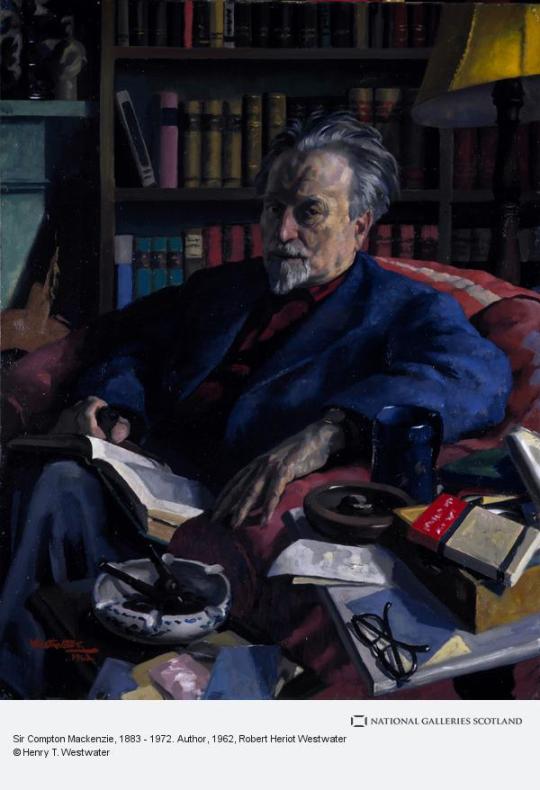
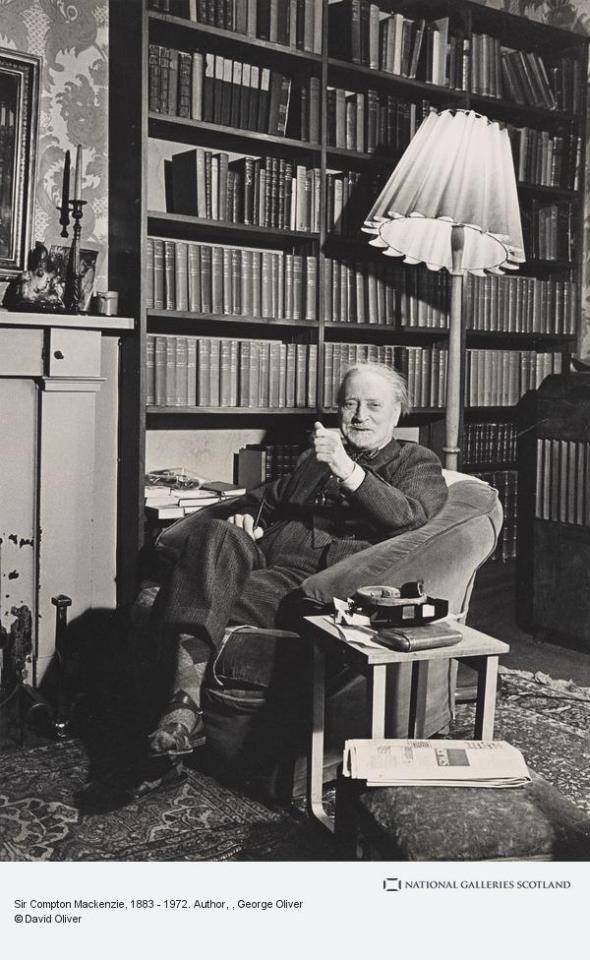

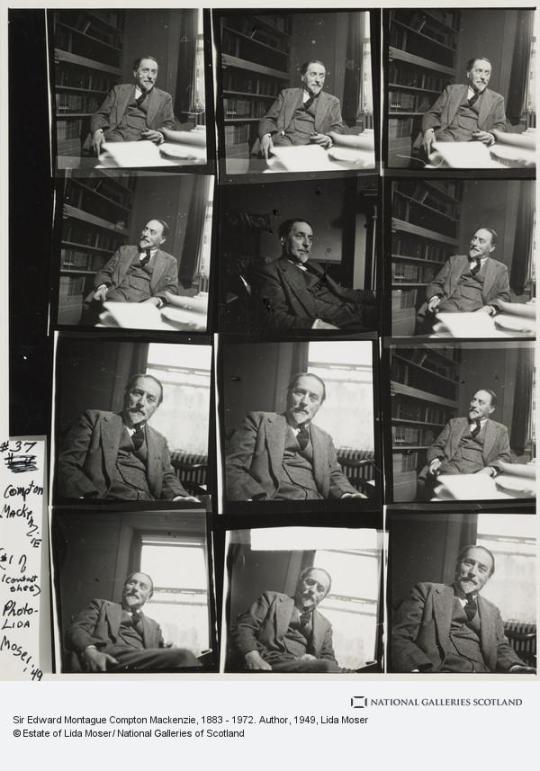


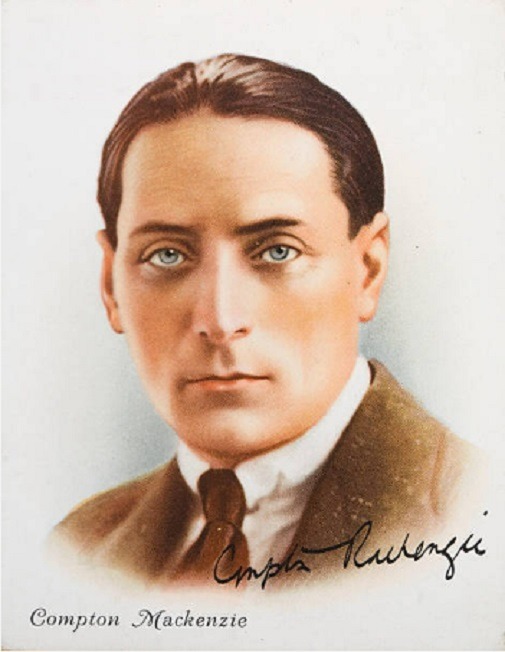
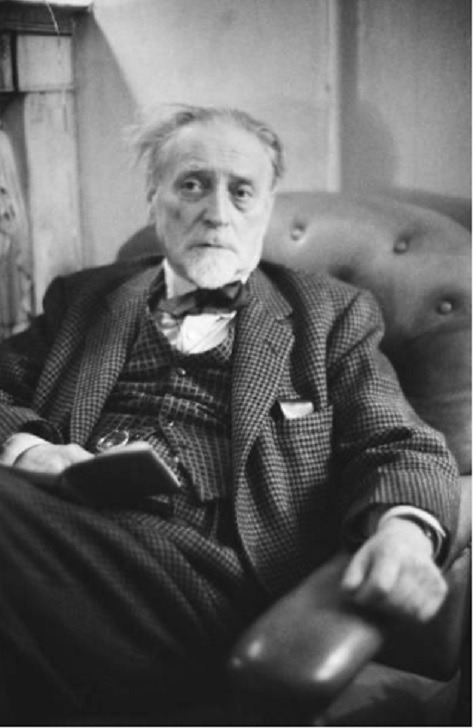
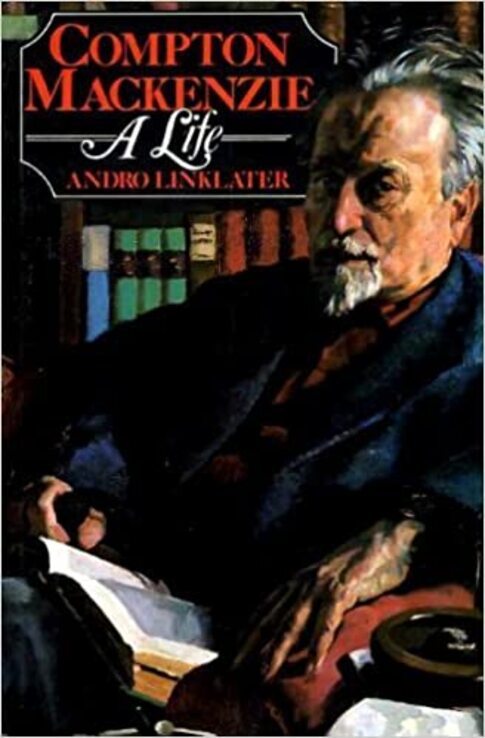
The last two posts were meant to be scheduled for tomorrow, oh well onto todays anniversaries....
January 17th 1883 saw the birth of the writer Compton Mackenzie.
I've explained in mainy posts that just because you weren't born on Scottish soil, it doesn't mean you are not Scottish, well I'll leave it to the Scottish writer Andro Linklater this time tp exoplain Compton Mackenzies credentails, not that they should be needed. Liklater penned a biography on Mackenzie, so is more than qualified;
“(He) wasn’t born a Scot, and he didn’t sound like a Scot. But nevertheless his imagination was truly Scottish.”
Edward Montague Compton Mackenzie was born in West Hartlepool in 1883 and raised in London. His was a theatrical family – many of whose members used Compton as their stage name. His grandfather Henry Compton was a well-known Shakespearean actor of the Victorian era. A history graduate of Magdalen College, Oxford, the young Mackenzie published his first novel in 1912 but his writing career was stalled by the outbreak of war.
He quickly signed up and saw action at Gallipoli. In 1915 he was recruited into the fledgling Secret Service and was posted across the eastern Mediterranean. Although he would later be awarded a knighthood, Mackenzie was no darling of the British establishment. In 1932 he was hauled before the courts and fined for breaching the Official Secrets Act for writing Greek Memories – a candid reflection of his time as a spy. At a time when the British public was scarcely aware of the security services, Mackenzie freely outlined its organisation. It was withdrawn from sale and was only published in full as recently as 2011.
In 1933 he took revenge on the Secret Service with Water on the Brain, an obvious swipe at the Service. Despite its satirical cover, he managed to include a few genuine morsels – such as the fact that the chief of the Service always wrote in green ink. At story’s end, the location of the Secret Service’s headquarters is revealed in a spy thriller and the spooks have to move out. The building becomes an asylum for “the servants of bureaucracy who have been driven mad in the service of the country”. By this point Mackenzie was already resident in Scotland and had become close friends with the poet Hugh MacDiarmid and the influential writer, thinker and adventurer Robert Cunninghame Graham. Together they helped establish the National Party of Scotland in 1928, which emerged in 1934 as the modern SNP.
Mackenzie settled on the Hebridean island of Barra and concentrated on his most ambitious project, The Four Winds of Love. Gavin Wallace, another of his biographers, later wrote: “The Four Winds of Love, published in six volumes between 1937 and 1945 and containing almost 1 million words, is one of the most ambitious Scottish novels of the twentieth century, an enormous historical odyssey which anatomizes the politics of peripheral nationalism both throughout Europe and in Britain, again through semi-autobiographical character development.”
But it was Mackenzie’s comic novels that won him wider fame and fortune. Whisky Galore, based on a real-life incident in Eriskay in 1941, was first adapted for the big screen by Ealing studios and released to popular acclaim in 1948. The enduring appeal of the novel was later summed up by one Scotsman literary critic:
“So what if it perpetrates the old, cliched ‘Brigadoon’ myth? Scots, English, American or Martian, no-one can resist this tale of ill-gotten whisky gain on a Scottish island in wartime. It’s simply hilarious.”
Such was Mackenzie’s status as an elder statesman of letters he was knighted in 1952 and remained a much-respected cultural commentator for the rest of his life. In later years he lived in Drummond Place, in Edinburgh’s New Town, where he died from cancer aged 89, in 1972, he is buried on Barra.
Lavish tributes followed. Dr Robert McIntyre, president of the SNP and the first Scottish nationalist elected to parliament, described Mackenzie as “the Grand Old Man of Scotland”. Novelist Eric Linklater said he was a “consummate stylist, who, unlike most writers, also lived with style.”
There are many Mackenzie quotes I could call on, but my favourite is
“Love makes the world go round? Not at all. Whisky makes it go round twice as fast.”
19 notes
·
View notes